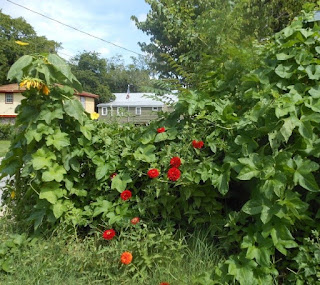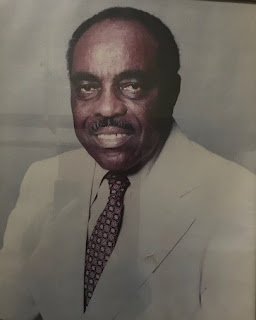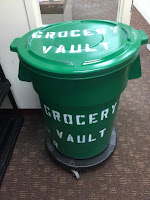Eastside History Series: Charleston’s Back Yard by Dr. Susan Millar Williams
 |
| Hanover Street Garden, 2012 |
With the East Side fast becoming one of Charleston’s most desirable neighborhoods, it is hard to remember that it was once a place where the city relegated eyesores and polluters. Tanneries released foul odors and noxious liquids into its creeks and marshes. Hogs and cattle were slaughtered at “butcher pens” that supplied meat for the city market. Garbage carts dumped trash in the streets, slowly building up new land from the detritus of life downtown. The city dump, with its flocks of buzzards, gave way to an incinerator that spewed showers of ash. Industrial engines and locomotives alike belched clouds of smoke.
In its heyday as an upscale suburb, Hampstead, as it was then known, boasted an expansive park and a handful of palatial homes. It even had a botanical garden, near the site of the now-vacant grocery store many Eastsiders still think of as the Piggly Wiggly.
But for almost a century, Hampstead was also the place where Charleston warehoused its poor. The City Almshouse once occupied the corner of Columbus and Drake Streets, where the former Wilmot J. Fraser Elementary School now stands. The building was not originally designed to house unfortunate people. Like the structure we now know as the Cigar Factory, it was built as a textile factory, with a central tower and open floors to accommodate spindles and looms. When that first textile factory went broke, only a few years after it opened, the building was repurposed to provide board and lodging for people too old or too sick to support themselves.
The Almshouse was, at least for its time, a benevolent institution. Outside of the city, there was no official provision for helping what one nineteenth-century writer bluntly called “the lame, the halt, the blind, and the poor.” In spite of a rule that required six months residence inside the city limits in order to qualify for free care, it was not uncommon for rural people to come to town and beg the authorities to admit them to the Almshouse or the city hospital. But as Walter J. Frazer points out in his book Charleston! Charleston!, the Almshouse was also a place where people deemed “unworthy” were punished for the crime of being poor. It was governed by a Master and a Matron, and the residents were referred to as “inmates.” There were a lot of women among the “indoor pensioners,” some of whom were pressed into service to care for motherless infants, and in the years after the Civil War there were a fair number of disabled Confederate veterans. The Almshouse also distributed food to nonresidents, who were called “outdoor pensioners.” The “rations” were pretty basic—rice, grits, sugar, flour, maybe a little bacon. But they helped tide families over from one week to the next.
The Almshouse served only white Charlestonians. Black paupers were sent to an even grimmer institution on the other side of town.
 |
| The Almshouse after the earthquake. |
At 9:06 on the night of August 31, 1886, a tremendous earthquake rocked Charleston, bringing down the central tower and shattering some of the walls. The master and matron managed to get all one hundred terror-stricken residents out of the building safely, even though many were, as the City Yearbook crudely put it, “cripples and imbeciles.” In addition to providing temporary shelter for the displaced. the city was faced with the huge task of repairing or replacing most public buildings, including the Almshouse. Even with donations pouring in from all over the nation, the cost was staggering. Committees were put in charge of collecting bids from contractors and figuring out what to do. And most of the bids came in far higher than the city was prepared to pay. The Almshouse was no exception.
Alderman Francis S. Rodgers proposed that the city buy the venerable Mills House Hotel, on Meeting Street, downtown, and convert it into a new Almshouse. Once one of the city’s fanciest luxury hotels, just steps from Hibernian Hall, the Mills House had been used for years as a boarding and apartment house. It was already laid out with individual rooms and areas for cooking and dining. It did have lots of stairs, which would create problems for inmates with mobility issues. But in other ways, it seemed well suited for use as what we would now call a residential care facility.
Rodgers was at the time one of the wealthiest men in Charleston. His brand-new mansion on Wentworth Street, complete with stained glass designed by Louis Comfort Tiffany, had survived the earthquake with minimal damage. And as the News and Courier was careful to note, he had good intentions. But Rodgers’s proposal to move the Almshouse “was received with a shudder.” A
 |
| The Mills House. (National Archives.) |
“It is very well,” the paper declared, “to keep the paupers in the background, away off in the outskirts of the city, where there is plenty of land to cultivate, and where the sad spectacle of broken-hearted poverty may not offend the vision of those who sit down in their own comfortable homes.” In other words, the poor belonged in Charleston’s back yard.
City Council soon voted to repair the original Almshouse. The poor would remain in residence there for more than half a century, though in 1913 its name was changed to the gentler-sounding “Charleston Home.”



Comments
Post a Comment